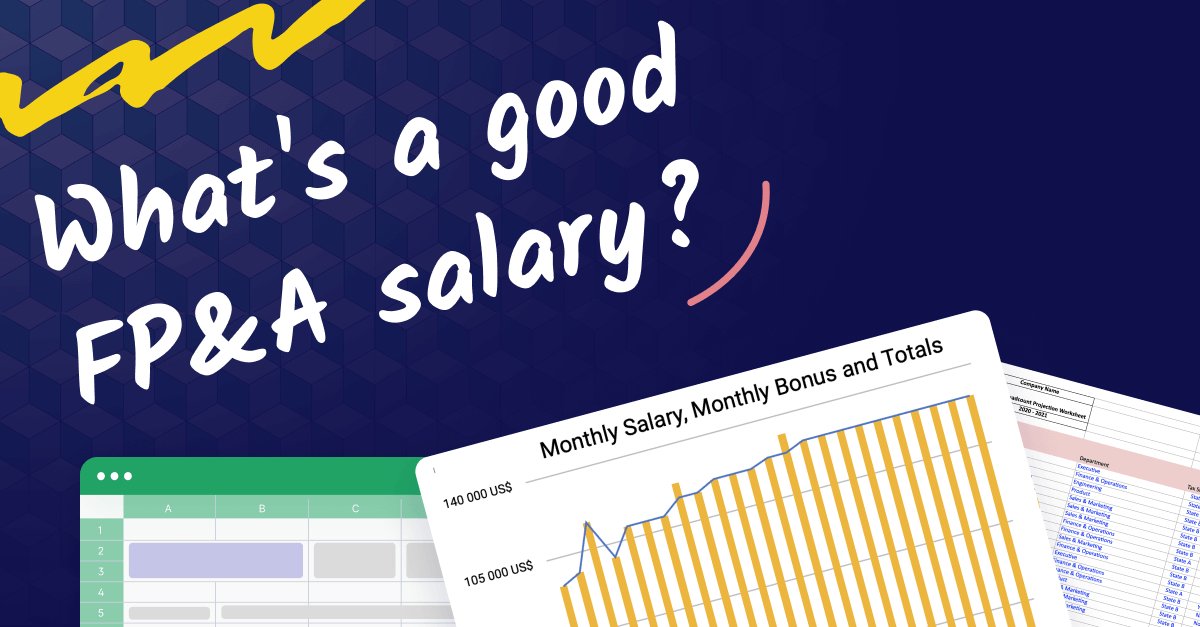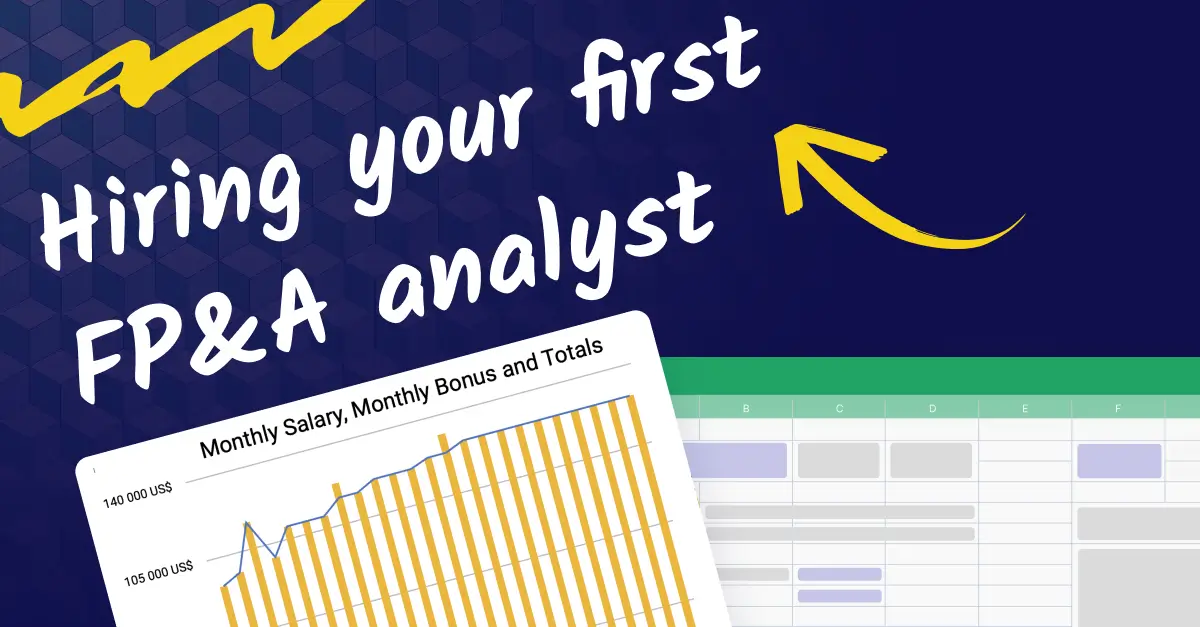What are the roles in financial planning and analysis (FP&A)?
Before we get into the specifics, let’s do a quick overview of FP&A in general. FP&A is an in-house corporate function that typically consists of analysts, managers, and directors or VPs.
Together, they’re responsible for tracking, analyzing, and evaluating all financial activities within the organization. This involves a wide range of responsibilities, including:
Although this may vary by organization, generally speaking, FP&A analysts are responsible for consolidating data and building financial models, while senior analysts and managers focus more on planning and business forecasting.
FP&A analyst
An FP&A analyst is a junior to intermediate-level role primarily tasked with gathering and maintaining data and building financial models. Responsibilities often include:
- Tracking, analyzing, and evaluating financial activities
- Creating monthly financial reports for departmental heads
- Evaluating ROI of current assets and investments
- Examining ratios like debt to equity and interest coverage to gage overall financial health
- Identifying cost-cutting opportunities
- Identifying financial and operational risks
- Offering financial planning recommendations to senior management and stakeholders
Typical FP&A analyst salary range
The base salary range for most FP&A analysts in the United States is $50,000-$80,000 per year—with an average base salary of $70,506.
Typical time spent as an FP&A analyst
It usually takes 3-5 years to progress from analyst to senior analyst.
During that time, the role may evolve from consolidating data and building reports to working more closely with senior management and stakeholders and sharing insights or recommendations.
Typical profile of an FP&A analyst
Analysts are rarely hired right after completing an undergraduate degree. The typical candidate will have at least 1-3 years of experience, most likely in accounting. To succeed, analysts should also be:
- Organized and detail-oriented: Analysts are expected to work with large volumes of sensitive and critical data, often under tight deadlines, so organization and attention to detail are equally critical.
- A problem solver: Analysts don’t just wrangle data, but break down the full range of an organization’s finances to formulate different growth scenarios.
- Spreadsheet savvy: In addition to proficiency with Excel or Google Sheets, some organizations look for experience with Enterprise Resource Planning (ERP) software like SAP or Oracle NetSuite. Data manipulation skills like SQL or Power Query will also come in handy for cleaning and sorting data.
FP&A senior analyst
Senior analysts may have graduated from routine data collection, but they are still very much on the front lines regarding the company’s finances. At this stage, analysts typically shift their focus to business forecasting, financial modeling, and planning.
Senior analysts also work closely with the executive team to make recommendations and support executive decision-making. Responsibilities often include:
- Conducting scenario analysis to map out future growth plans and financial forecasts
- Building predictive budgets
- Performing variance analyses on budget and forecasts to identify areas for improvement and provide guidance on future trends
- Keeping a pulse on economic and business trends to anticipate potential obstacles
- Creating internal financial reports for the executive leadership team, possibly supplemented by data visualization tools and dashboards
- Making recommendations to leadership to increase profitability
- Reviewing financial models created by analysts
Typical FP&A senior analyst salary range
The typical salary range for a senior analyst in the US is $65,000-$125,000, with an average of $90,430.
Typical time spent as an FP&A senior analyst
Senior analysts can typically expect to spend 3-5 years in their role before moving on to FP&A manager.
Typical profile of an FP&A senior analyst
Senior analysts usually come from accounting backgrounds and have 3-5 years of experience and an MBA. To continue advancing, senior analysts should be:
- “Good at dealing with people”: Communication skills will become increasingly important the further you go in your FP&A career. Senior analysts frequently step in as trusted advisors on all things finance, so it’s crucial to effectively communicate complex financial data, differences in performance, and recommendations to senior management and leadership.
- Data visualization skills: The ability to create custom dashboards and enhance financial reports with graphs, tables, and charts will be invaluable. Some senior analysts may use data visualization solutions like Power BI, Tableau, or FP&A software to easily incorporate data visualization into their spreadsheets.
- Excel mastery: At this stage, we’re not just talking conditional formatting, but pivot tables, dynamic formulas, and the works. Although you can take shortcuts with automated data consolidation, senior analysts are universal spreadsheet experts.

FP&A manager
Next up is the FP&A manager, who is typically responsible for leading a team of analysts and senior analysts.
Managers work closely with executives and provide insights to support decision-making. They’re also charged with ensuring daily FP&A operations run smoothly. Common responsibilities include:
Typical salary range of an FP&A manager
The typical base salary for an FP&A manager in the US ranges from $70,000 to $150,000 per year. $105,667 is the average manager salary within that range.
Typical time spent as an FP&A manager
Like other FP&A roles, managers will usually spend 3-5 years at this level, before they are equipped to move on to the next.
Typical profile of an FP&A manager
FP&A managers usually have 5-10 years of experience, with the vast majority possessing an MBA or CPA. They also require the following to succeed:
- Leadership skills: Enabling, motivating, and supporting analysts and senior analysts to deliver high-quality work requires strong leadership and performance management skills.
- Efficiency: To ensure processes are running smoothly, managers need to have a knack for operational efficiency and the ability to quickly execute improvements.
- Communication: Managers don’t just work closely with analysts and executives, but also with business head units throughout the organization. Clear communication and collaboration are both critical to success.
Director or VP of FP&A
Often reporting directly to the CFO, the Director or VP is the most senior role in the FP&A chain of command.
They essentially supervise the entire FP&A function, which may involve:
- Developing a top-level strategy for managing corporate finances
- Directing all FP&A processes
- Reviewing team performance
- Assessing reports for new growth opportunities
- Sharing insights, recommendations, risks, and rewards with executives and shareholders
Typical salary range of a director or VP of FP&A
The typical finance executive salary range for a director or VP of FP&A in the US is $145,000 - $200,000 per year, averaging $197,500.
Typical time spent as a director or VP of FP&A
It can take 10 years to work up to the director or VP level—and another 5-10 to become a CFO (although this varies by industry or organization).
However, as CFO roles are highly competitive, some FP&A directors/VPs may alternatively seek to transfer to another function like Corporate Development or Business Development.
Typical profile of a director or VP of FP&A
A director / VP of FP&A will likely have at least 10-15 years of experience in corporate finance. To succeed at this level, they are also:
- Analytical: Directors and VPs aren’t in the weeds, but they still need to be able to effectively analyze the reports their team generates and connect critical findings to long-term goals and business strategy.
- Strong leaders: Directors and VPs know how to lead and provide clarity, agency, and support necessary to operate a unified and efficient FP&A team.
- Diplomatic: Directors and VPs can translate complex information with tact and diplomacy. This is especially important when communicating with executives and shareholders.
These professionals command a competitive salary range, reflecting the value they bring to organizations in driving financial strategy and decision-making. Understanding the dynamics of finance executive salary is integral to navigating and advancing in this career path.

Common questions about FP&A salary ranges
Is FP&A high-paying?
Although average base salaries can vary by industry and organization, FP&A roles are generally high-paying.
The average salary for an FP&A analyst—the most junior-level role—is still $70,506 per year, and can scale to $200,000 per year at the director or VP level—sometimes even higher!
What is the average base salary of an entry-level FP&A analyst?
At the entry-level, the average salary for the analyst role is between $50,000 - $80,000 per year. More junior analysts can expect to earn on the lower end, while those with more experience can command high salaries.
As always, salary is just one piece of your total compensation, so be sure to take that into account when evaluating a job offer.
Is FP&A a promising career?
Yes. FP&A plays a crucial role in any organization, maintaining its importance even in times of financial uncertainty or economic downturns.
Stability is a key feature of careers in FP&A, with roles such as analysts, managers, and directors/VPs typically experiencing consistent demand. This resilience makes FP&A a particularly promising field for long-term career growth.
Is an FP&A certification worth it?
If you already have a CPA, CFA, or MBA, you will be perfectly equipped for an FP&A role, and likely won’t require additional certification or online courses to get started.
Should I get an MBA to work in FP&A?
You can work as an FP&A analyst without an MBA. However, this could limit you as you get further in your career, as most successful candidates for mid-to-senior-level FP&A roles do have an MBA.
Additionally, the average starting finance professional salary for MBA graduates is 22-40% higher.
Is an FP&A analyst the same as a financial analyst?
Yes and no.
Financial analyst is a broader term that can describe several roles involved with financial analysis, including FP&A analysts.
However, financial analysts may also refer to financial professionals with external clients, notably investment banking.
FP&A analysts only work within their corporation. That is, their clients and stakeholders work for the same company that they do.
Does a CFA help me earn more in FP&A?
Yes! Studies have shown that having a CFA can increase your finance professional salary by up to 47%.
Can FP&A lead to CFO?
Absolutely. According to Deloitte, 47% of CFOs have background experience in FP&A.
It’s easy to see why. Succeeding in FP&A requires analyzing and communicating complex data, managing critical processes, working closely with a wide range of stakeholders, anticipating obstacles, and identifying new growth opportunities.
You also have to be fluent in an organization’s finances. Although becoming CFO is never guaranteed, you could hardly ask for better preparation than an FP&A career path.
CFOs at several organizations worked in FP&A first, including Kate Bueker at HubSpot, Ann Gugino at Papa John’s, and Thomas Dreher at Heinz.
Understanding the FP&A career path
In the world of finance, there's a whole range of specializations and roles to choose from. For anyone eager to carve out a successful path in this field, it's pretty important to have a clear grasp of the various career stages and directions you could take.
The Beginning: Entry-Level Positions
Starting your journey in finance typically involves entry-level positions. These roles, such as Junior Financial Analyst, Accounts Assistant, or Audit Associate, provide foundational experiences that are critical for understanding the basics of finance. At this stage, you’re building skills like financial reporting, basic analysis, and getting familiar with financial software.
Mid-Level Progression: Specialization and Management
As you gain experience, the path diverges into more specialized roles. You might find yourself drawn towards corporate finance, investment banking, risk management, or even FP&A (Financial Planning & Analysis). Mid-level positions like Financial Analyst, Risk Manager, or Portfolio Manager require not just technical skills, but also an ability to analyze complex data and make strategic decisions. This is also the stage where management skills begin to take center stage, as many roles involve leading teams or projects.
Advanced Roles: Senior Management and Beyond
Reaching senior management positions, such as Finance Director, VP of Finance, or Chief Financial Officer (CFO), means having a combination of deep financial expertise, strategic thinking, and strong leadership abilities. These roles involve making high-level decisions that affect the entire organization, requiring an extensive understanding of market trends, regulatory environments, and organizational strategy.
Educational and skill requirements for FP&A
A career in FP&A requires a blend of formal education, relevant certifications, and a diverse skill set that goes beyond number crunching. It’s a field that offers immense opportunities for those who are prepared to keep learning and evolving.
Educational background
Most professionals in FP&A start with a strong foundation in finance, accounting, or economics. A bachelor’s degree in one of these fields is typically the minimum requirement. However, in an increasingly competitive landscape, many are turning to further education. An MBA or a master's degree in finance or accounting can provide a deeper understanding of business and financial concepts, which is invaluable in FP&A roles.
The role of certifications
Certifications can also play a pivotal role. Credentials like the Chartered Financial Analyst (CFA) or Certified Public Accountant (CPA) are highly regarded in the finance world. They not only demonstrate a commitment to the field but also provide advanced knowledge and skills that are beneficial for FP&A professionals.
Essential Skills
While educational qualifications are important, the skill set you bring to the table is equally crucial:
- Analytical skills
- Strategic thinking
- Technical proficiency
- Communication skills
- Attention to detail
FP&A job market trends and insights
Here we explores key developments in the FP&A job market, shedding light on what employers value most and how professionals can thrive in this dynamic field. By staying ahead of these trends, FP&A professionals can position themselves as invaluable assets in 2024 and beyond.
Increased Demand for Data Analysis: FP&A professionals with strong data analytics skills are highly sought after as businesses rely on data-driven decision-making.
Hybrid Work Models on the Rise: The adoption of remote and hybrid work models has gained momentum, providing increased flexibility to FP&A professionals.
Emphasis on Advanced Financial Modeling: Employers highly value expertise in advanced financial modeling techniques, particularly for scenario planning and forecasting purposes.
Technology Integration in FP&A: The incorporation of financial software and tools, including Enterprise Resource Planning (ERP) and data visualization solutions, is now a standard feature in FP&A roles.
Economic Uncertainty Management: The ability to navigate economic uncertainty, including market volatility and regulatory changes, is a key skill in demand.
Sustainability Reporting: As sustainability becomes a critical aspect of business, FP&A professionals may be involved in tracking and reporting on environmental, social, and governance (ESG) metrics.
Conclusion
From the most junior analyst to the VP, FP&A teams are the lifeblood of strategic finance.
The FP&A career path, while demanding and challenging, offers remarkable stability and the potential for substantial financial rewards.
Typically, you can expect to invest about 3-5 years at each level before advancing to the next. This gradual ascent ensures that with each step, your skills and value within the organization grow exponentially. With dedication and skill, it could very well lead you directly to a position in the CFO's office.
Unlock the full potential of your FP&A career with Cube software. Experience the future of strategic finance with a free demo today.



.png)








![FP&A team structure, responsibilities, and how to scale [2025]](https://www.cubesoftware.com/hubfs/budgeting-best-practices%20%281%29-1.webp)
